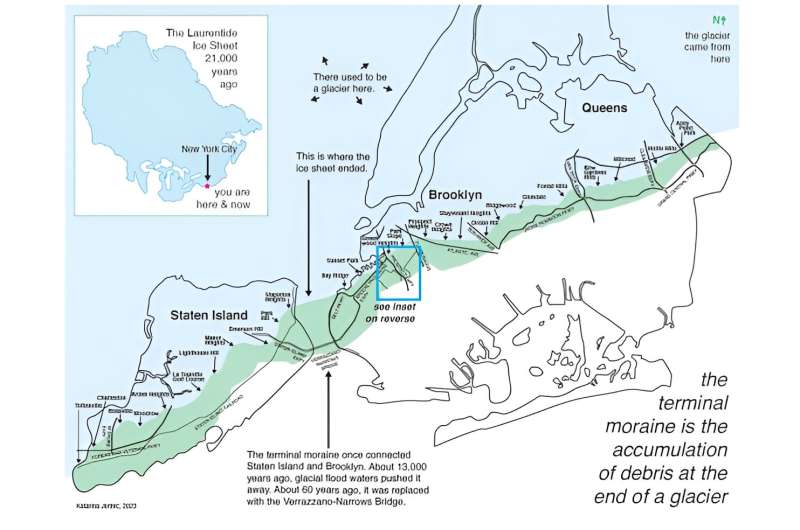This article has been reviewed according to Science X's editorial process and policies. Editors have highlighted the following attributes while ensuring the content's credibility:
fact-checked
trusted source
proofread
Dredging up New York City's glacial memory

On a cold night in November, a small group gathered at the boathouse of the Brooklyn-based Gowanus Dredgers to listen to Elizabeth Case, a glaciologist and Ph.D. student at Columbia Climate School's Lamont-Doherty Earth Observatory, talk about how glaciers formed and defined the landscape of New York City.
Arriving with a Ziploc bag filled with "glacier goo"—created by mixing borax with Elmer's glue—Case invited attendees brave enough to remove their gloves to experience the simulated glacier surface. "It's the perfect weather to get you feeling like you are on a glacier," joked Case, who has studied these moving bodies of ice in Wyoming, Alaska and West Antarctica.
"Glaciers are like big memory banks—and pretty much everything I love about a glacier has to do with how it remembers things like climate stresses and then writes that memory into the landscape that we live in," Case said.
New York City's "memory bank" was formed by the Laurentide Ice Sheet, which covered millions of square miles, including most of Canada and a large swath of North America, about 18,000 years ago, Case said. This ice sheet fundamentally shaped the topography of New York City, she added, as demonstrated by the city's construction and where we've elected to put green spaces, cemeteries and neighborhoods.
To understand how glaciers had this impact, you need to look at how they move. Glaciers may appear stationary, but they actually flow under their own weight, like honey, carrying rocks and scouring the landscape as they go. This becomes apparent in the large geologic features they leave behind. Big boulders dropped along the way are known as glacial erratics. Huge piles of rock and debris that melt out at the front of glaciers and ice sheets create what glaciologists call the terminal moraine, or the farthest reaches of a glacier. In New York, this ridge stretches from the southern end of Staten Island through Brooklyn and Queens, including Greenwood Cemetery, Brooklyn's highest point.
The exact reasons for which areas of the city have been more developed over the years are complex and would require a deeper study of the city's building and zoning decisions, but it's possible the land surrounding the terminal moraine was easier to build on, less rocky and less steep, leaving the rubble-strewn terminal moraine as a less expensive option for cemeteries, woodlots, and similar spaces.
A quick look at Google Maps can help confirm the above. Trace the green spaces that cut through Brooklyn, from Staten Island through Forest Park, and you trace the terminal moraine of the Laurentide Ice Sheet.
The Laurentide Ice Sheet has written stories all over New York. In many of the rocks in Central Park, you can even see the scratch marks left behind by the frozen rock dragged along with the glaciers. The Hudson River itself was formed by the melting of the ice sheet in an enormous outburst flood, breaking through the terminal moraine between Staten Island and Brooklyn to connect the river to the ocean. "We can almost play back from the present and rebuild what the glacial history would have looked like based on how New York has been developed," Case said.
While the evening offered just a brief introduction to the magic of glaciers, for anyone whose interest in the research was piqued, Case presented the following wisdom from a former professor: To be a glaciologist, you need to know two essential things—how to dress warm and dig holes.
Provided by Earth Institute at Columbia University
This story is republished courtesy of Earth Institute, Columbia University http://blogs.ei.columbia.edu.




















